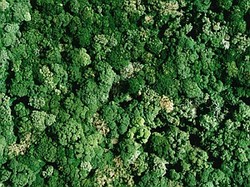The formation of gaps in a forest has a profound influence on tree species richness and the patterns of forest structure

Fig. 1: An aerial photograph of the canopy of the Tatera Forest in southern Japan, an example of an old-growth evergreen broadleaf forest.
c 2010 S. Yamamoto
When large trees are blown over or die, they leave gaps in the forest canopy. Shin-Ichi Yamamoto of the Nagoya University GCOE for Environment Studies and co-workers1 have now shown that the processes of forming and refilling these gaps contribute to the mosaic of diverse, species-rich tree patches seen in ancient Japanese forest.
The researchers studied an area of the Tatera Forest (Fig. 1), an evergreen broadleaf forest located on Tsushima Island in the warm-temperate region of southern Japan. "The Tatera Forest Reserve covers an area of around 100 hectares and has been strictly preserved for centuries as part of religious practices," explains Yamamoto. "This makes it an ideal site for studying the role of gap-forming processes in shaping community structure in an unspoiled old-growth forest ecosystem."
The researchers used aerial photography and long-term ecological monitoring records to assess changes in the community structure of the forest. During a detailed field survey they also measured the height and diameter of trees, saplings and wood debris in representative forest patches. By combining these approaches they were able to reconstruct the gap-forming processes that have occurred in the forest over the past four decades.
The primary causes of small-scale disturbances in the forest are typhoons, which blow over individual trees and break off stems and branches. However, the researchers found that the events following this initial occurrence of gap formation are highly diverse. Gaps can be filled quickly by fast-growing species, or can expand and connect with other gaps. Eventually, a closed canopy redevelops, but gaps appear again as mature trees age and fall.
The researchers identified four distinct patch types with different structures: patches consistently closed by canopy trees, patches that used to be open but are gradually closing, patches that were open or adjacent to open areas in 1966 and have been expanding, and patches with gaps that have formed since 1966.
They recorded a total of 34 tree species, with individual patches containing between 15 and 29 species. The species composition was not clearly related to past gap-forming processes except in large patches with canopies that still remain open -- such patches contained the highest number of species, including fast-growing deciduous trees.
Nevertheless, the variations in gap-forming processes have created a complex mosaic of patch types by generating environmental heterogeneity both vertically and horizontally in this species-rich old forest. "Forests have previously been likened to Swiss cheese, consisting simply of gap and non-gap areas, but the reality is far more complex," says Yamamoto.
Affiliated Researchers
The Nagoya University affiliated authors mentioned in this highlight are from the From Earth System Science to Basic and Clinical Environmental Studies GCOE program of the Graduate School of Bio-Agricultural Sciences.
Reference
- Manabe, T., Shimatani, K., Kawarasaki, S., Aikawa, S.-I. & Yamamoto, S. I. The patch mosaic of an old-growth warm-temperate forest: patch-level descriptions of 40-year gap-forming processes and community structures. Ecological Research 24, 575-586 (2009). | article